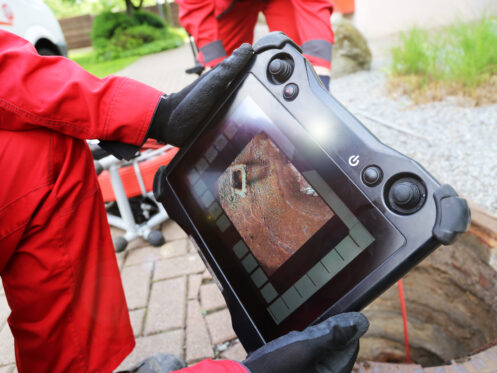A plumbing inspection not only ensures that your home’s water and drain systems will run efficiently, but it can also spot problems that could cost you thousands of dollars if unaddressed. Homeowners may want to know what to expect before one of our plumbers begins the process. Here is a closer look at what you ought to expect.
Inspection Length
The size of the house and the complexity of the plumbing system will affect the length of the inspection. Inspections in some smaller houses with basic plumbing setups may take an hour. Conversely, an inspection of a large house with a complex system could take up to four hours.
Equipment
Most plumbing inspections involve a handful of tools. Our plumbers often have drain cameras, infrared cameras, pressure gauges, and leak detection tools. The infrared camera is often our first point of reference because it allows us to survey a large part of the plumbing system. We can then drill down on smaller areas that might have problems.
Main Water Line Inspection
A typical inspection begins with the main water line because we want to rule out any outside issues before we look at your home’s specific needs. We check the meter to verify that it’s operating within 2% accuracy high and low. Our plumbers also inspect the shutoff valves to ensure they’ll be ready for use in case of an emergency. We will verify that the pressure from the water line is between 40 and 60 pounds per square inch (PSI), the recommended range for most residential buildings. Likewise, we will confirm that the main line can deliver between six and 12 gallons per minute, which is a good enough flow rate to support multiple high-use activities.
It is also a good idea to check the materials used for the main line. Our goal is specifically to make sure there aren’t any lead lines. However, we will also check for lines that are galvanized steel, copper, or PEX. Knowing the line’s material will tell us how long it is likely to last. We also can check for corrosion and leaks.
Drain Lines
Getting water out of the plumbing system is just as important as getting it in. Using a camera with an adjustable scope, we will check the drain lines to ensure that they’re running without obstructions to the main sewer line. We will look for common issues like grease buildup, root intrusions, foreign objects, clogs, and mineral deposits. Our plumbers also check the slope to confirm that there’s at least a quarter-inch of drop for every foot of drain length, thus ensuring proper flow. If necessary, we can flush or treat the drains to encourage flow.
Vents and Traps
The ventilation and trap systems ensure that gases from your home’s plumbing system have a way to escape without causing problems for you. We will check the condition of the vent stack, confirming that it can’t leak gas inside. Also, we will check that the weather protection keeps ice and snow out of the vent.
Similarly, our plumbers will check the traps in the system. These are bends that fill with water to prevent gases from feeding back into your drain system. We also check floor drains to ensure that they’re not feeding gases back into your home’s basement, laundry room, or other areas.
Water Heater Inspection
Whether your home has an electric or a gas water heater, we would be happy to inspect it. On electric heaters, we can test the voltage and ground. We also can ensure that the upper and lower heating elements are operating at their target wattages. Our plumbers look at the anode rod, an anti-corrosion device. The anode rod often requires replacement every three to five years, and we can quickly address this issue. We can even evaluate the r-value of the water heater’s insulation.
On natural gas and propane heaters, we are equipped to check carbon monoxide levels and venting. We can test the gas line pressure, too. Our plumbers always check the temperature relief valve to ensure it operates correctly at 210 degrees F and 150 PSI.
Fixtures
Our plumbing inspection checklist extends to fixtures like toilets, faucets, showers, and bathtubs. We will look for common leak issues, such as the wax ring on the bottom of a toilet and the trap under a sink. The inspection also covers the flow rates for toilets, faucets, and shower heads to ensure they stay below the current legal maximum and high enough to function.
We inspect valves for faucets and showerheads to confirm that they’ll balance the water pressure in your kitchen and bathroom. The checklist also includes caulking and sealing around fixtures. We will look for signs of water leaks and trace them to their sources if necessary. Right down to checking the drain flow for the sinks, tubs, and faucets, we want you to be confident that your plumbing system will do its job well.
Pipes
As with the main line, we will look at the types of materials used in your plumbing system’s piping. We will use leak detection equipment to search for potential losses in the system. Likewise, we will confirm that the system can hold its pressure with a 5% range over 15 minutes. Thermal imaging also allows us to find cold or hot spots that may indicate a leak. Similarly, we will check the joints for leaks and corrosion.
Water Softeners and Other Treatment Systems
If your home features a water softener system or some other form of water treatment, we will check its condition. We can check resin beds, brine tanks, regeneration cycles, and bypass valves for integrity. Our inspection also includes any attached filters, including how well the water pressure is passing through them.
Documentation and Reporting
Finally, we will provide you with documentation of our plumbing inspection, and we include a report detailing our findings. If the customer orders any maintenance or repair work, we will also document completion.
Documentation and reporting serve several roles. If your insurer requires an annual inspection, our reports help you demonstrate a good-faith effort to meet the requirements. Documenting a regular history of plumbing inspections is also good if you ever wish to sell your house. Buyers like to see documentation that a professional has regularly looked at a plumbing system. After all, plumbing problems can cause potentially tens of thousands of dollars in water damage.
Pacific Plumbing & Rooter Inc is proud to serve the residents of Eugene, OR, as well as Springfield and the surrounding areas. If your plumbing inspection reveals that your home might require some work, we can provide a free estimate for the job. Our team is happy to tackle jobs like well service, drain cleaning, piping repairs, and work on water treatment systems. We are also comfortable with drain and sewer projects, and we can often perform trenchless work. Our company is a small local business that puts decades of experience to work for our customers.
If you think your Eugene or Springfield home needs a plumbing inspection, call Pacific Plumbing & Rooter Inc now.







